
|   |

|   |
 e-mail: sunilkothari1933@gmail.com 15th Dhauli-Kalinga Mahotsav 2019 Photos courtesy the festival February 20, 2019 I have been regularly attending the festival since its inception in 2003. Held at the backdrop of Dhauli peace pagoda, its ambience is enchanting. The Dhauli stupa and nearby temple are lit up. The artists, dignitaries, organizers are invited on the opening evening to hold mashals, the torches aloft and to the sound of the conch, the festival is inaugurated. The ceremony is awe inspiring. It suggests cherishing the idea of love, peace, compassion and humanity. The festival is a grand celebration of harmony between history and modernity. This is the very place where after the Kalinga war, on banks of Daya River, emperor Ashoka took to Buddhism. The festival held on this spot gives signals for peace in contemporary times. At the very outset, I would like to congratulate dancer, choreographer, guru and an organizer par excellence Aruna Mohanty for mounting such an amazing festival. A worthy disciple of late Guru Gangadhar Pradhan, she has imbibed his style admirably, runs Orissa Dance Academy, teaches there and has to her credit several large scale dance works, doing her guru proud. The first opening 'Gita Mahatmyam' and the final 'Make in Odisha' took one's breath away. The conceptualization and flawless execution using the classical dance forms with stunning visuals and melodious music are the hallmarks of these productions. 'Gita Mahatmyam' was born in a small discussion group with Swami Dayanand Saraswati and came to life under Kalavardhini (a small think tank under his guidance) in Chennai. By fortuitous circumstances, I was invited by Aruna to see it when I was in Chennai. To put Gita in a dance format is a big challenge. But she took it up inviting three other choreographers - Gauri Diwakar for Kathak, Anitha Guha for Bharatanatyam and Janardhan Raj Urs for contemporary dance. Aruna used Odissi and Gotipua forms. The linkage and flow are smooth and flawless. For script, she received support from lyricist Kedar Mishra and scholarly inputs came from Nityananda Mishra. Music was composed by Ramhari Das, whereas rhythm was provided by Dhaneswar Swain. The original concept was by Kalavardhini along with Aruna Mohanty. There was one more advantage. While the stage at The Music Academy in Chennai was not large enough for a cast of more than 60 dancers, the specially built stage at Dhauli with two separate upper stages on either side, gave enough space for the scale which Aruna had in mind for the production. The entries and exits by the dancers were smooth. Also the projection of images on the large screen added an extra dimension to the presentation as the visuals complimented the group dances. 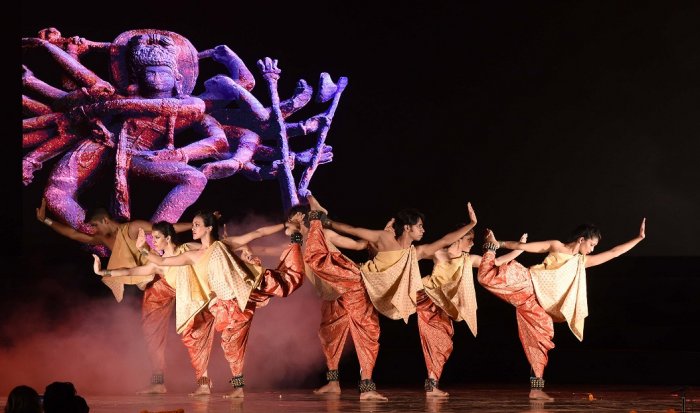 Gita Mahatmyam Photo: Arabinda Mahapatra What strikes one at the very outset in this one hour production is the handling of the key tenets of the ancient text which incorporates the philosophy of Bhagavad Gita as relevant to our times and lives even today. Aruna along with her co-choreographers has given visual forms to the tenets in an arresting manner. Arjuna in the battlefield is unable to confront his own cousins and drops his Gandiva bow before Lord Krishna, his charioteer, stating that his entire body is atremble, how can he fight with his cousins. Lord Krishna reassures him giving examples. Whoever has read Gita or studied its shlokas by heart would automatically recite with musicians, what Krishna says: 'The body is a mere vessel. Like old clothes it has to leave (vashanshi jirnani, yatha vihaya tatha sharirani) and Atma is reborn again'. In an excellent Kathak mode using footwork, and dropping scarves from the body, the meaning of leaving old clothes and wearing new ones is conveyed artistically. The incorporation of tarana adds to the beauty of formation. The Odissi group's pallavi and Bharatanatyam group's tillana make interesting interludes. In one sequence Pavitra Bhat, the gifted Bharatanatyam dancer playing role of Arjuna, is lifted on the shoulders of the dancers. The reference to different stages of life, as child Krishna stealing butter, playing with ball and jumping into river to subjugate serpent Kaliya; to suggest youth Radha Krishna are shown as yugal to the tune of tana dere na and later on the final journey is conveyed with four dancers carrying the body of the corpse in the background on an upper level. The way the various levels of the stages are used keeps the movements of different groups flowing without colliding. The famous shloka wherein Lord Krishna says to Arjuna, 'Sarva dharman pritajya, mameka sharanam vraja' (leave all religions, faiths and come unto me) is often used as refrain enhancing the need for what one has to do, and one must follow. To illustrate further, Krishna explains to Arjuna that out of kama, desire and lust comes attachment, from inability to possess comes the feeling of anger, leading to delusion and finally to wither and perish. Aruna has taken the story of Ravana kidnapping Sita and the various consequences he faces. The enactment of coming in disguise as a mendicant by Ravana and then the final battle between Rama and Ravana, one notices the marvel of the choreography, when Ravana is seen with ten dancers, and how one by one they fall with arrows shot by Rama. The well known shloka 'Yada yada hi dharmasya glanir bhavati Bharata' means whenever the world is in difficulty, Krishna says he takes various incarnations. Using Dashavatara from Gita Govinda, this has been delineated well. Each choreographer is given to interpret different incarnations. The story of Buddha deals with four stages of men - childhood, youth, old age and then the dead body taken for burning. In Kathak, this is shown by Gauri Diwakar. Since earlier the same theme is explained by Krishna to Arjuna, these four stages are danced resulting in overstatement and repetition. This can be avoided and elaboration for Buddhavatara by mere reciting of 'Buddham saranam gacchami' could be more effective. 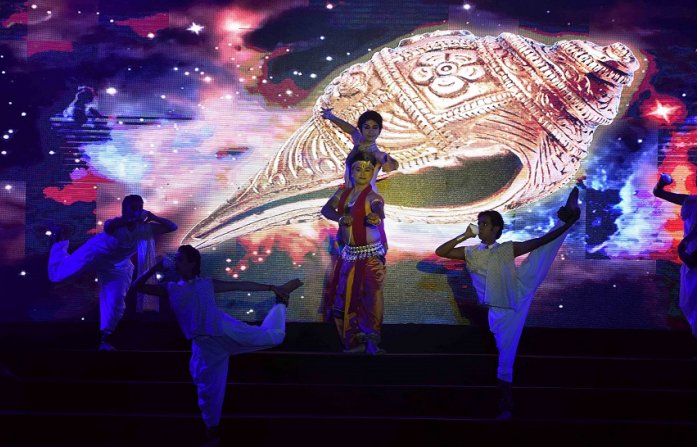 Gita Mahatmyam Photo: Arabinda Mahapatra The most interesting aspect of 'Karmanyave adhikaraste', your job is to do your duty, is interpreted by modern dance choreographer Janardhan when he shows India's independence and how Gandhiji undertook Dandi March to break the law by picking up salt. The dancers come with wooden sticks and walk using the sticks which they turn into spinning wheel, a charkha, and on screen is projected the national flag. Gandhiji used Karma yoga by adopting non-violence and Gita's tenet. The young in the audience gave instant ovation - the message was conveyed. When I first saw it at The Music Academy, I had some reservations about bringing in contemporary theme but it suited well for the present times. The dancers dressed in white costumes and waving white flags created strong visuals. Gandhiji understood that it was his duty, karma, to fight whether we would achieve independence or not. 'Ma faleshu kadachana' - the fruit is not to be desired. When Krishna reveals his Vishwarupa, there are brilliant flashes of choreography. Krishna says to Arjuna that he is best among many objects. He is divine conch, the best elephant Airavata, and the visuals on the screen and those created by the dancers are imaginative, matching the graphics. The vision of Krishna as Vishwarupa has Krishna standing in front, and behind him a series of men bending create a curve by several heads. The multiple form is created in a most fascinating manner. When Krishna says the soul cannot be destroyed by water, fire, wind, rain and so on, the visuals projected on the screen are enacted by dancers with appropriate hastas and sthanas. The use of navarasas, the planets and the sun, the stars, the splendid colours all merge into lord's form which takes a gigantic scale. In the finale, Krishna is surrounded by all dancers in different styles and we see Krishna with peacock feathers around him, creating an impressive visual. The dance presentation suggests that the battle of Kurukshetra is not physical one, but is representative of the battles within each of us. When we watch Arjuna, we realize that we all are Arjuna with the same questions, the same dilemmas. Gita Mahatmyam thus succeeds in conveying its principles through dance with mythological stories and contemporary issues, handled by the four choreographers without anyone attempting one upmanship, and with a sense of deep understanding and spirit of collaboration. The second presentation was of Mayurbhanj Chhau Dance by Mayur Art Centre from Bhubaneswar. It often happens in a festival of such scale that after the most powerful work the following work, if weak in concept and execution, fails to hold the attention of the audience. The story of the soldiers, their fight against the British and the ruling Maharaja giving them honours somehow appeared weak, and looked like old dance dramas with dated costumes. Whoever is in charge of this centre would do well to plan the presentation in a manner that would engage attention of the audience. The costumes need rethinking. Day two Like earlier years on the second day, Mahodadhi, the musical orchestra by Dhaneswar Swain and group Vadya Vanee, was presented in the beginning creating wonderful impact with an array of musicians, sitarists, violinists, percussionists, tabla, mardala, the ginni, flute and what have you. The ensemble was most impressive. Standing on one side, Ramhari Das rendered the song which is of a shared tradition and on the other side Dhaneswar Swain recited the ukutas, the mnemonic syllables weaving magic. The graphics shown on the screen with videos of waves of ocean, merged with the drumming matching in equal measure. The projection of Rathayatra and images of Lord Jagannath were apt making meaning of the song rendered. The collective playing transformed the ambience and the musical imagination by the two musicians, lifting the spirit of the audience. Such an attempt to explore music reminded one of the attempts of Pandit Ravi Shankar who advocated orchestral ensembles. Odisha's heartbeats were felt in this attempt of Mahodadhi. 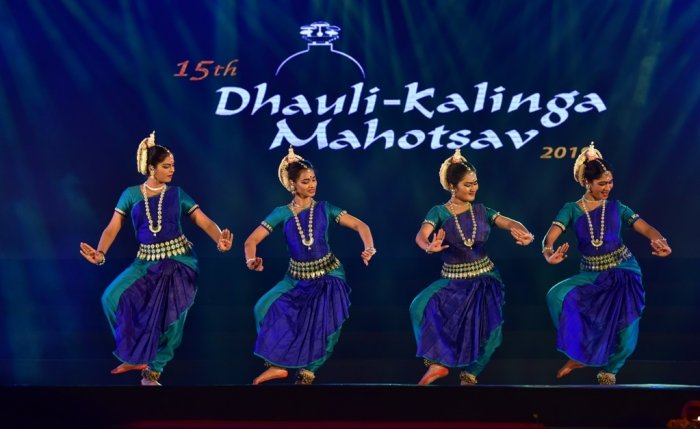 Srjan ensemble Ratikant Mohapatra, son of the revered Guru Kelucharan Mohapatra, with his abundant gifts as a dancer, guru, mardala player, and a choreographer with the troupe of Srjan Guru Kelucharan Mohapatra Odissi Nrityabasa, one of India's premier Odissi dance institutions, presented two choreographic works. Ratikant works towards creating awareness about Odissi dance with a modern approach, while preserving the rich classical nature of the art. With one of the best repertory groups in India, Srjan ensemble is known for its fast-paced movements, innovations in dance and music and also depiction of popular themes. As a master choreographer, he chisels his dancers who perform with uniform technique, creating a myriad of patterns, exploring various geometric groups that astound one like watching kaleidoscopic variety of eternal beauty. Such perfection, alignments in movements et al, speak of his modern outlook, professionalism, and raising the bar of dance. It is a sheer pleasure to watch the dancers executing movements with perfect chauka, the spring board of Odissi. In nritta, the formations whether diagonal, or in a straight horizontal line, or groups having centrifugal and centripetal formulations, Ratikant scores in choreography creating visuals which leave an indelible impression. The dancers with their slim, agile and lithe bodies dancing in an effortless manner engage attention of the audience from the word go. Their costumes with preference for blue and Debiprasad Mishra's exquisite lighting are impressive. The music is translated into excellent movements so that the dance and dancers become one. The Kiravani Madhurima, musical composition in Telugu by Dr. Vyzarsu Balasubrahmanyam with text in praise of the goddess, translated into Sanskrit by scholar Nityananda Mishra and choreographed by Ratikant, transforms into a work of sheer beauty. The text merges with the musical mode perfectly and the dancers give both the music and the text visual shape. The melody has a haunting quality. Ardhanarishwara, the celebrated work of Shankaracharya to the original music by late Pandit Raghunath Panigrahi, finds a felicitous treatment in hands of Ratikant, investing the work with exquisite images of the duality of male and female, two halves in one body. Two dancers standing one behind and one in front, holding one palm on face suggesting half, one arm entwined like serpent round the neck, other arm held upwards, create the Ardhanarishwara image. The several dancers along with two dancers, weave fascinating patterns as the text describes the various epithets of Parvati and Lord Shiva. The refrain "Champeya gaurardha sharira" creates the delicate beauty of Parvati and with ashes besmeared on the body of Lord Shiva. The description of various ornaments, garland of Mandara flowers on Parvati and the skulls for Shiva, the delicate sound of ankle bells of Parvati and serpents as ornaments on feet of the Lord, the dancers taking the position of raised hood for serpents complimenting the image where serpents are not mere decorations, but have an all pervading presence. The silken garments of Parvati, and the directions becoming the garment of Shiva as Digambara, are arresting visuals. Dancers play upon drums creating the image of tandava of the lord. The one with refrain of 'prachand shristi', when the lord destroys, has excellent group formation. The dancers form a circle sitting on the floor and move holding hands and one dancer impersonating Shiva performing vigorously leaves an indelible impression. The interchanging and moving in effortless manner, makes the work gripping. The finale with opening position of Shiva and Parvati is seen in exquisite balance. Within twenty minutes Ratikant has created, with his own signature, an engrossing work. The lighting changes with the moods of the song. When 'Prachanda tandava samharaya' is danced, the dancers are bathed in red light with great effect. From Imphal came Thang Ta artists of Manipur Thang-Ta Cultural Association to astound the audience with their traditional skills of martial arts, dancing with swords, shields and spears, attacking the opponents with such force that when the swords clashed there were fire sparks in the air. Watching their acrobatic feats the audience often had their hearts in their mouths. Three artists played with three bamboo sticks, with two swords balancing, throwing up the bamboo sticks and holding it with great agility. Two swordsmen attacking one opponent, three of them fighting, then two men come revolving a bamboo stick, the ends of which are lit with fire, the third man comes and fills up his mouth with kerosene and blows fire from his mouth, startling the audience. But the most amazing was the performance of a man blindfolded with a piece of a cloth, when a handful of earth is placed on his closed eyes, so that there is no chance of his seeing anything. There are two females sitting on either side holding cucumber in their hands, which he slices moving in different directions. The cucumber placed on the chest of a lying female he slices with such dexterity that one marvels at it. The audience gave them rounds of applause for their amazing feats. Day three 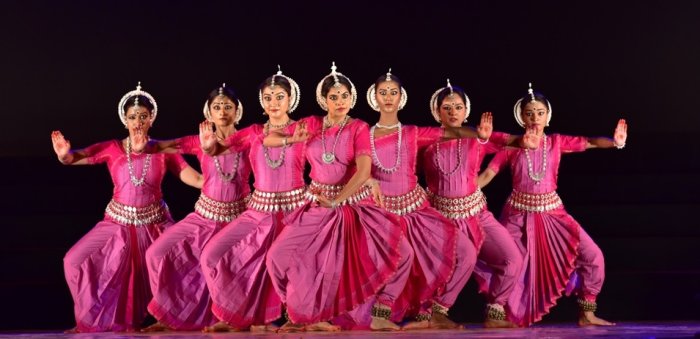 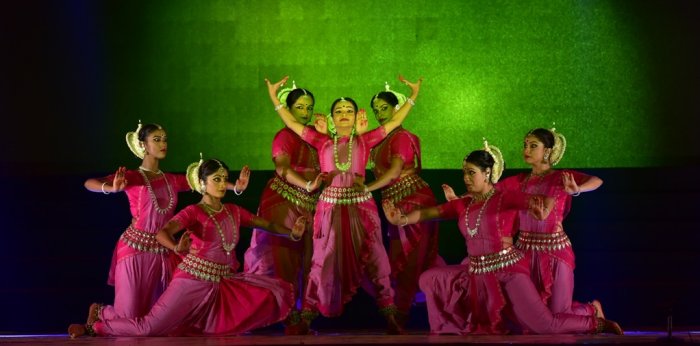 Madhulita Mohapatra and group On the third day, from Bangalore Nrityantar institution run by young Madhulita Mohapatra brought two group compositions in Odissi. Disciple of Guru Gangadhar Pradhan, Aruna Mohanty, Pabitra Kumar Pradhan and Guru Krushnachandra Sahoo, Madhulita has succeeded in establishing Odissi in Bangalore within a short span of ten years, training a sizeable number of students. Madhulita selected two group works: Shiva Dhimahi in praise of Lord Shiva choreographed by her and a Kannada Purandaradasa pada set to Odissi music. The former had arresting formations with several dancers. Odissi offers a choreographer chance to create iconic multi-armed forms of the deity imaginatively. Set to ragamalika and talamalika the group work details the epithets of the lord to the refrain of "Hara Hara Shankara," with the lord playing upon damaru. He is Shashishekara, with moon on his jata, also holds Ganga in his matted locks, the serpents are his ornaments. The recitation of sabdaswarapata like composition was incorporated effectively. The music by Sukanta Kundu was complimentary. The dancers performed with uniform technique. To integrate with Kannada people, Madhulita chose Purandaradasa's pada which extols how Vishnu saved his devotees. When Gajaraja was caught by crocodile, Vishnu sent the Sudarshan chakra and saved his life. Prahlada worships Narayana and his father Hiranyakashipu cannot tolerate it. He throws him into a pit where poisonous serpents reside, but they do not harm Prahlada. Hiranyakashipu throws him in fire, but he is not harmed. Finally he asks where his god lives, to which Prahlada says he is everywhere. Hiranyakashipu shows him a pillar and strikes it with his mace, and lo and behold, in form of half lion and half man, the lord appears and kills Hiranyakashipu. The entire dramatic event was choreographed by Madhulita. Similarly the story of Draupadi vastrapaharana, the game of dice, Yudhisthira losing Draupadi in stake and Dushashana being ordered by Duryodhana to drag her in full view of the court pulling her sari. He even gestures to helpless Draupadi to come and sit on his lap. Krishna saves Draupadi's modesty by providing endless saris and Dushashana falls on the floor exhausted. Purandaradasa sings praise of the lord who is savior of his devotees when they are in trouble and seek his help. Enacted dramatically, the pada is a welcome attempt to enlarge the repertoire of Odissi. Since several Odissi dancers have adopted songs of various languages, this attempt is a welcome step on part of Madhulita. The pronunciation of some of the Kannada words can be improved upon and the flavour of Odissi music has to be maintained. Madhulita's choreographic works have a praiseworthy standard. 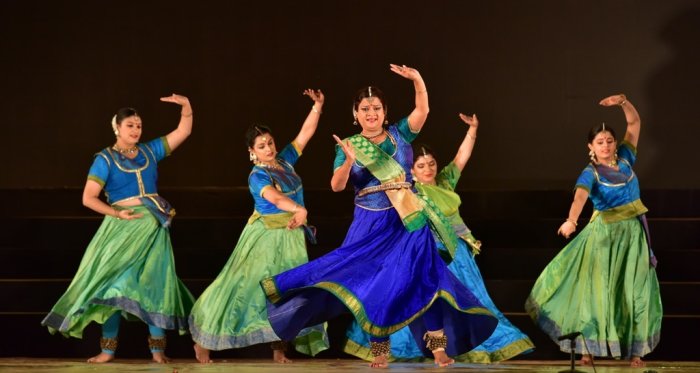 Rani Khanam and group From Delhi, the renowned dancer Rani Khanam, a senior disciple of Pandit Birju Maharaj, represented nazakat, delicacy and khubsurati, beauty of Lucknow gharana, with her well trained dancers. She presented a pada of ashtachhap sakha Surdas describing the beautiful dance of Krishna - 'Nachat sudhanga'. The original music was ascribed to veteran musician Anil Biswas. Melodious and creating images of bowers of Brindavan, river Yamuna, "Brindaban tat natat nartana, manjul mana vimal, sacal kunjan, jala Jamuna sundar," Rani wove in intra forms of tode, tukde, amad, paran taking palta and decorated the dance with graceful movements highlighting the beauty of Lucknow gharana. The poetry of Surdas found a felicitous expression in her abhinaya and dancing of her troupe. But the piece de resistance was her choreography of Vallabhacharya's Yamunashtalakam for which she herself set the music. For me it was a sheer delight as I had studied Yamunashtakam in my childhood and I could recite it even today with equal relish. 'Namami Yamunamaham, sakalasiddhi hetum muda murari pada pankaj sfurat mand renutkatam.' Ah, what a pleasure it was to see these images taking shape before one's eyes! 'I bow to that Goddess Yamuna who fulfills all my desires, who has the lotus feet of Lord Krishna on her banks'. Rani Khanam created visuals in Kathak parlance. The flow of Yamuna river with waving arm movements by the group, the pirouettes, chakkars for whirlpool of waters and one saw the river flowing in all its grandeur. She later on introduced tatkar, the foot work, the melodious tarana, and also jugalbandi with bols and swaras. The entire work was replete with Kathak vocabulary. I was delighted that one of my most favourite poems was choreographed with such sensitivity. Rani Khanam is a name to reckon with in the world of Kathak. Her own choreography of Sufi saint poets has won her international reputation and unqualified success for expanding the boundaries of Kathak repertoire. Equally at ease with Braj literature as with Islamic literature, she is a link between religions that aim at oneness. 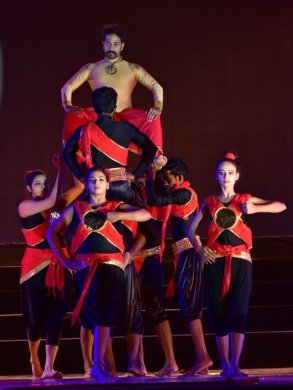
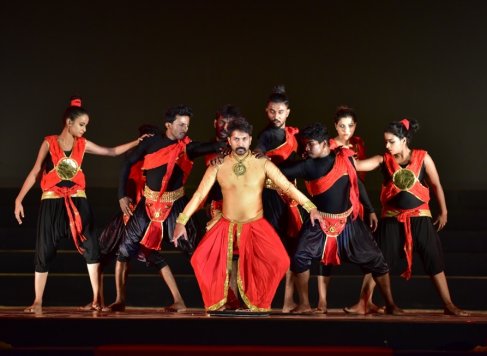 Sreejith and group Sreejith T.R. and group from Kerala presented Kalaripayattu, the martial art of Kerala, in a story form. Sreejith has a formidable reputation as a kalaripyattu exponent, besides being a choreographer in Indian films. He has also been a judge for 25 film reality shows. His Dancity Academy is affiliated to NSIM, Govt. of India, and also with Trinity College. Despite his close association with Malayalam film industry, his presentation was free from any filmy touches. The rulers of Calicut, the Zamorins encouraged the martial arts. As a royal patron sitting on a throne, Sreejith demonstrated all the basic practices of Kalaripyattu right from Namaskar to various fights with a variety of weapons. His agile body, bearing and costumes were impressive. The entire troupe performed with great energy, using various props. Thoroughly professional, Dancity Academy's presentation of Kalaripayattu was in a novel, but authentic form. 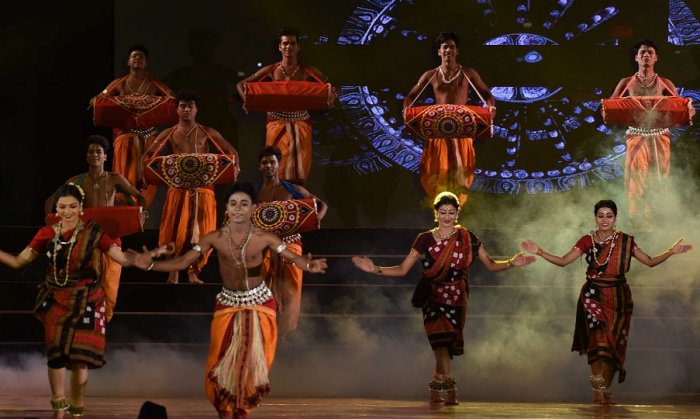 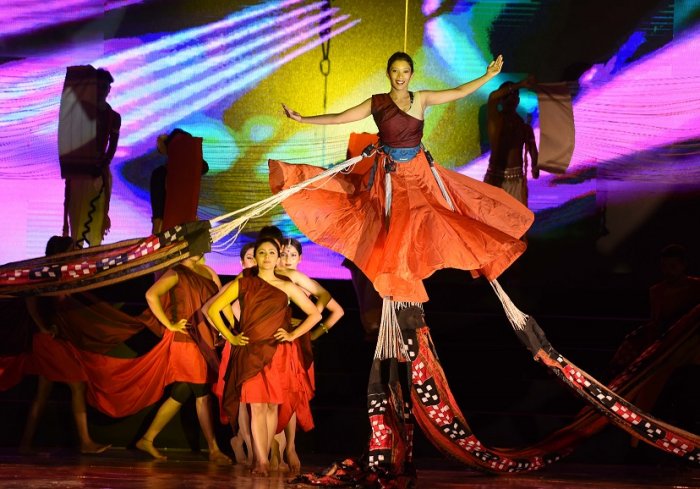 Make in Odisha What we all were waiting for with bated breath was the mega production Make in Odisha. Its canvas was broad, covering numerous episodes of the historical glory and artistic excellence of Odisha. The accompanying commentary was full of pride for Odisha. 'I am the land of promise, progress, plenty and prosperity. My destiny charted by the wheels of the Juggernaut, the wheels of change, rolling ahead with time, coursing steadily and harmoniously into glorious future, energized by the pulse of a dynamic present and nurtured by the magnificence of a timeless past. I am unstoppable. I am Odisha!' Aruna Mohanty, Orissa Dance Academy, Moksha founded by Saiful Haque known as Babu, a modern contemporary dance teacher and choreographer, and Cornucopian Creations, Bangalore based contemporary dance institution known for contemporary creations, pulled their talents together to project the state of Odisha in its multifarious activities and progress including the past glory using the classical Odissi dance forms, Gotipua, folk dances of Odisha and with contemporary dances visualizing the industries, in its various aspects, using the state of art technology, dancers in a variety of costumes, entering from one end and exiting from another, and some descending from heaven with aerial dancing, took one's breath away. Mind boggling, quick, continuous, unstoppable, they created fantasy, with back projection of heavy industries, ports, rivers, ocean, forests, mines covering practically all the geographic areas of Odisha. Branding Odisha, wheels of progress, valleys, minerals, eco-tourism with Olive Ridely turtles and migratory birds, handloom that starts from thread and looks at fashion which wraps the world, references to Smart City that is Bhubaneswar, the sports, recent event of hockey, skilled work force, artificial intelligence and science Hi Fi with such an extraordinary finale that makes all Odisha people proud. The chef, the hotel staff, the fashion models, large wheels of Konark suggesting wheels of progress, fashion models flying in heaven, and the configuration of all these on a scale which is vast, places this production in a class of its own. Aruna has emerged as a choreographer of big dimensions, enlisting collaborations with other dancers and modern dance groups to mount such a production. It also speaks volumes for her organizing capacity. The confidence she has won from the govt. and various agencies is well justified. Lalit Mansingh, the former Ambassador of India to USA, spoke in the end complimenting Aruna and team, including Ileana Citaristi, emphasizing that Make in Odisha is symbolic of entire India. That the present day young generation can achieve this in terms of visuals and dance is indicative of their dreams for the nation which are bound to come true. During the Mahotsava (Feb 8-10, 2019), few persons were honoured with sammans. Ruchi Buddha Samman, with an amount of Rs I lakh, was conferred upon the renowned scholar, author and creator of musical Sampoorna Gita Govinda, former chief secretary of Odisha and secretary of govt. of India, Subas Pani. Guru Gangadhar Pradhan Smruti Samman 2019 was conferred upon flute maestro Mohini Mohan Patanaik, Chaiti Ghoda folk artist Utsab Charan Das, Pratap Das, founder of Indian Performing Arts Promotions Inc. (IPAP) in Washington to promote arts of Odisha in USA, and editor, translator, journalist, scholar, human rights worker, cultural activist and poet Kedar Mishra. The two comperes Srinibas Ghatuary and Anuja Tarini Mishra did an excellent job of introducing the artists. Srinibas has a natural flair for speaking in Odiya which is mesmerizing and poetic. Anuja besides being Orissa service officer and a vocalist did her job in a self effacing manner in English with required information. They deserve congratulations for their professional work. Due credit needs to be given to Odisha Tourism, Govt of Odisha, several sponsors, several schools and colleges who sent their young students in large numbers offering them an opportunity to witness such a bonanza of culture. Dhauli - Kalinga Mahotsav has doubtless acquired a prestigious reputation among the dance festivals of India.  Dr. Sunil Kothari is a dance historian, scholar, author and critic, Padma Shri awardee and fellow, Sangeet Natak Akademi. Dance Critics' Association, New York, has honoured him with Lifetime Achievement award. Post your comments Please provide your name and email id when you use the Anonymous profile in the blog to post a comment. All appropriate comments posted with name & email id in the blog will also be featured in the site. |